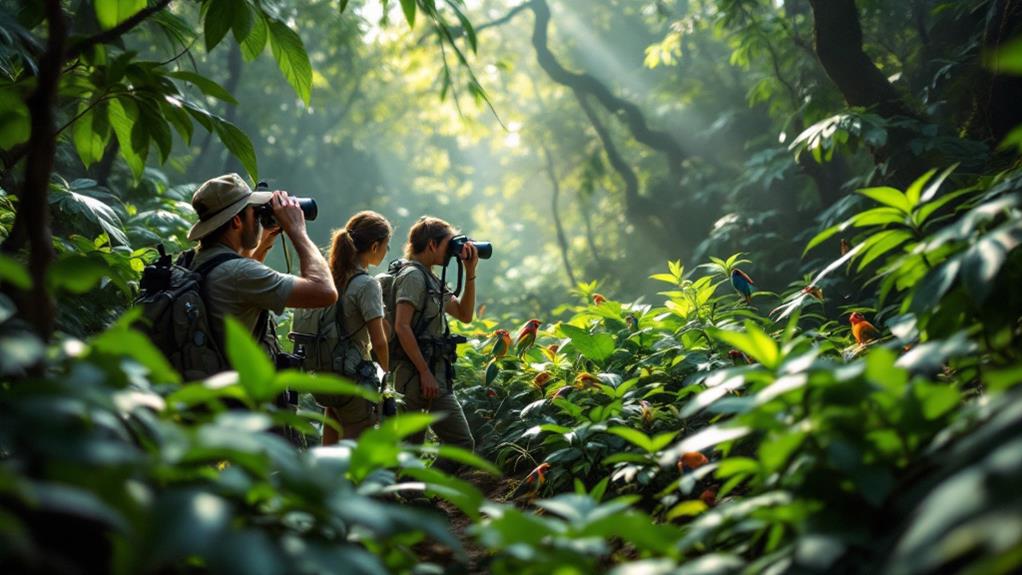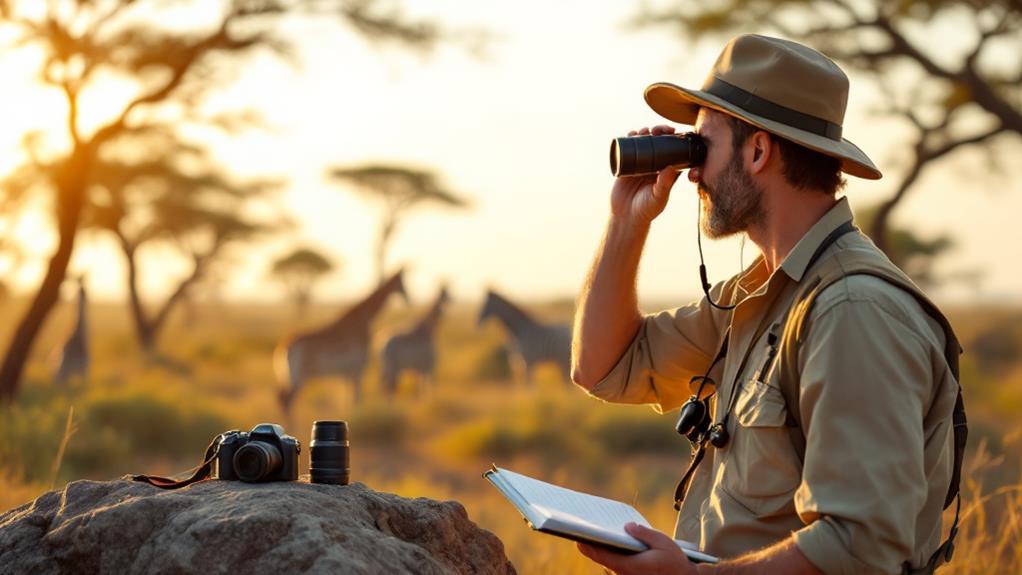Zoology research methods span a wide range of techniques to study animal life. You'll use field observation for direct animal watching, often aided by tools like binoculars and camera traps. Animal tracking technologies, including GPS collars and radio telemetry, help monitor movements and behaviors. In the lab, you'll conduct experiments on animal models and analyze DNA samples. Behavioral studies involve creating ethograms and long-term observations. Population surveys and remote sensing applications provide broader ecological insights. You'll also employ comparative anatomy and conservation research strategies. These diverse approaches offer an all-encompassing toolkit for understanding the animal kingdom. Exploring each method reveals the intricate world of zoological research.
Field Observation Techniques

Three essential field observation techniques form the foundation of zoological research in natural habitats. These techniques are direct observation, capture-mark-recapture, and remote sensing. Each method offers unique insights into animal behavior, population dynamics, and ecological interactions.
When you're conducting direct observations, you'll spend extended periods watching animals in their natural environment. You'll need to remain as unobtrusive as possible, often using blinds or camouflage to avoid disturbing the subjects. Take detailed notes on behaviors, interactions, and environmental factors. Use binoculars or spotting scopes for distant observations, and consider employing time-lapse or video recording for continuous data collection.
Capture-mark-recapture involves temporarily catching animals, marking them for identification, and releasing them back into their habitat. You'll then conduct subsequent captures to estimate population size and track individual movements. This technique requires careful planning to minimize stress on the animals and guarantee accurate data collection. Use appropriate trapping methods and marking techniques that won't interfere with the animal's natural behavior or survival.
Remote sensing allows you to gather data without direct contact with animals. You'll use tools like camera traps, GPS collars, or acoustic monitors to collect information on animal presence, movement patterns, and vocalizations. This method is particularly useful for studying elusive or dangerous species. When setting up remote sensing equipment, consider factors like battery life, weather resistance, and data storage capacity.
Animal Tracking Technologies
Animal tracking technologies have revolutionized zoological research, allowing scientists to monitor wildlife with unprecedented precision and minimal disturbance. You'll find these tools invaluable for studying animal behavior, migration patterns, and population dynamics. GPS collars are among the most widely used devices, providing real-time location data for various species. They're particularly useful for tracking large mammals and birds over vast distances.
Radio telemetry is another essential technique you'll encounter. It involves attaching small transmitters to animals, enabling you to locate them using a receiver and antenna. This method works well for studying smaller creatures or in areas where GPS signals are weak. For marine life, you'll often employ acoustic tags that emit sound waves detected by underwater receivers.
Satellite tags have become increasingly popular for tracking migratory species. They transmit data to orbiting satellites, allowing you to monitor animals across oceans and continents. You'll find these especially useful for studying sea turtles, whales, and long-distance flying birds.
Camera traps are indispensable for observing elusive or nocturnal animals. These motion-activated devices capture images or videos when an animal passes by, providing valuable insights into species presence and behavior. You can also use environmental DNA (eDNA) sampling to detect species in an area by analyzing genetic material left behind in water or soil.
As technology advances, you'll see more sophisticated tracking methods emerge. Miniaturized sensors can now measure an animal's physiological data, while AI-powered image recognition is enhancing camera trap analysis. By leveraging these cutting-edge technologies, you'll gain deeper insights into animal ecology and conservation needs.
Laboratory Experimentation Methods

Laboratory experimentation methods form an essential component of zoological research, allowing you to study animal behavior, physiology, and genetics in controlled environments. These methods provide you with the ability to manipulate variables and observe their effects on animals, leading to more precise and reproducible results.
When conducting laboratory experiments, you'll often use animal models to study specific traits or conditions. You might work with mice, rats, fruit flies, or zebrafish, depending on your research focus. These models allow you to investigate genetic mechanisms, test new treatments, or explore evolutionary adaptations.
You'll need to design your experiments carefully, considering factors such as sample size, control groups, and potential confounding variables. It's essential to follow ethical guidelines and obtain proper approvals for animal research.
Common laboratory techniques you'll encounter include:
- Behavioral assays: You'll observe and quantify animal behaviors in response to various stimuli.
- Physiological measurements: You'll monitor crucial signs, hormone levels, or organ function.
- Genetic manipulation: You might use CRISPR or other gene-editing tools to study gene function.
- Microscopy: You'll examine cellular structures and processes using various imaging techniques.
- Biochemical analysis: You'll analyze tissue samples or bodily fluids to study metabolic processes.
Data collection and analysis are critical aspects of laboratory experimentation. You'll use statistical methods to interpret your results and draw conclusions. It's important to document your procedures meticulously and maintain detailed records of your findings.
DNA Analysis in Zoology
DNA analysis has revolutionized zoological research, complementing traditional laboratory methods with powerful molecular tools. You'll find that these techniques allow for detailed investigations into species identification, evolutionary relationships, and genetic diversity within animal populations.
When you're working with DNA analysis in zoology, you'll often start by collecting samples from your subjects. This can involve blood draws, tissue biopsies, or even non-invasive methods like collecting shed hair or feces. Once you've obtained your samples, you'll extract the DNA using specialized kits or protocols.
Next, you'll amplify specific regions of interest using Polymerase Chain Reaction (PCR). This technique allows you to create millions of copies of targeted DNA sequences, making them easier to study. You'll then use various methods to analyze these amplified sequences, such as DNA sequencing, restriction fragment length polymorphism (RFLP) analysis, or microsatellite genotyping.
One of the most powerful applications you'll encounter is DNA barcoding. This technique uses short, standardized gene sequences to identify species rapidly and accurately. It's particularly useful when dealing with cryptic species or fragmentary samples.
You'll also find DNA analysis invaluable for studying population genetics and conservation. By examining genetic markers, you can assess population structure, gene flow, and inbreeding levels. This information is essential for developing effective conservation strategies and managing endangered species.
As you explore deeper into zoological research, you'll discover that DNA analysis continues to evolve. New techniques like next-generation sequencing and environmental DNA (eDNA) analysis are expanding the possibilities for studying animal populations and their ecosystems.
Behavioral Studies Approaches

Behavioral studies approaches encompass a wide range of techniques you'll use to observe, record, and analyze animal behavior in various contexts. These methods are essential for understanding how animals interact with their environment, each other, and humans. You'll often start with ethograms, detailed catalogs of an animal's behaviors, which serve as a foundation for further research.
In field studies, you'll employ techniques like focal sampling, where you focus on one individual for a set time, and scan sampling, where you record the behavior of multiple animals at specific intervals. You'll use tools such as binoculars, cameras, and voice recorders to capture data accurately. GPS tracking devices and radio telemetry can help you monitor animal movements over large areas or extended periods.
For more controlled experiments, you might set up laboratory environments or semi-natural enclosures. Here, you can manipulate variables to test specific hypotheses about animal behavior. You'll use video cameras and specialized software to record and analyze complex behavioral patterns.
When studying animal cognition, you'll design experiments that test problem-solving abilities, memory, and learning. These might include maze experiments, puzzle boxes, or touchscreen tasks for more advanced species.
You'll also consider the ethical implications of your research methods, ensuring minimal disturbance to the animals and their habitats. This might involve using non-invasive techniques like playback experiments or remote sensing technologies.
Population Surveys and Censuses
To accurately assess animal populations and their distributions, you'll need to master various survey and census techniques. These methods allow you to estimate population sizes, monitor trends, and understand species' spatial patterns.
One common approach is the line transect method. You'll walk along predetermined lines, recording all animals observed and their distances from the line. This technique works well for visible species in open habitats. For more elusive animals, you might employ capture-mark-recapture studies. This involves trapping animals, marking them, releasing them, and then recapturing to estimate population size based on the proportion of marked individuals.
Point counts are useful for birds and other vocal species. You'll stand at fixed points and record all individuals seen or heard within a specific time frame. For aquatic environments, you can use underwater visual census techniques or hydroacoustic surveys.
Remote sensing and GIS technologies have revolutionized large-scale population surveys. You'll analyze satellite imagery or aerial photographs to map habitats and estimate animal numbers over vast areas. Camera traps are invaluable for monitoring cryptic species, providing data on population density and behavior.
When conducting surveys, it's essential to evaluate sampling design, seasonality, and potential biases. You'll need to choose appropriate statistical methods to analyze your data and account for detection probabilities.
For long-term monitoring, you might establish citizen science programs. These engage volunteers in data collection, allowing for broader coverage and public involvement in conservation efforts.
Remote Sensing Applications

Remote sensing has revolutionized zoological research, building on traditional survey methods to provide unprecedented insights into animal populations and habitats. You'll find that this technology allows you to study animals and their environments from a distance, often using satellite imagery, aerial photography, or specialized sensors.
When you're working with remote sensing, you can track animal movements across vast landscapes. You'll use GPS collars or tags to monitor individual animals, helping you understand migration patterns, habitat preferences, and population dynamics. Satellite imagery lets you assess habitat quality and changes over time, which is vital for conservation efforts.
You can also employ thermal imaging to detect animals in dense vegetation or at night. This technique's particularly useful for studying nocturnal species or those in hard-to-reach areas. LiDAR (Light Detection and Ranging) technology helps you create detailed 3D maps of habitats, giving you insights into canopy structure and terrain features that influence animal behavior.
Remote sensing's not just about visuals. You'll use acoustic sensors to record animal vocalizations, helping you identify species presence and estimate population sizes. Underwater, you'll deploy sonar and other acoustic technologies to study marine life and their habitats.
Comparative Anatomy Methodologies
Delving into comparative anatomy methodologies, you'll find a diverse toolkit for analyzing structural similarities and differences among various animal species. These techniques allow you to explore evolutionary relationships, adaptations, and functional aspects of animal anatomy.
You'll often start with gross anatomical comparisons, examining overall body structures and organ systems. This involves careful dissection and documentation of anatomical features. You'll use specialized tools like scalpels, forceps, and magnifying glasses to reveal internal structures.
Histological techniques are essential for comparing tissues at the cellular level. You'll prepare thin sections of organs or tissues, stain them, and examine them under a microscope. This allows you to identify similarities and differences in cell types and tissue organization across species.
For more detailed analysis, you'll employ imaging technologies. X-rays and CT scans reveal skeletal structures without invasive procedures. MRI scans provide intricate soft tissue images, while electron microscopy allows you to examine ultrastructural features.
Molecular techniques complement traditional anatomical methods. You'll use DNA sequencing and protein analysis to compare genetic and biochemical similarities between species, providing insights into evolutionary relationships.
3D modeling and reconstruction techniques have revolutionized comparative anatomy. You'll use software to create digital models from anatomical data, allowing for precise measurements and comparisons.
Lastly, you'll integrate data from these various methodologies to draw conclusions about homology, analogy, and evolutionary adaptations. This thorough approach enables you to uncover patterns and principles in animal structure and function, contributing to our understanding of biodiversity and evolution.
Conservation Research Strategies

In the domain of conservation research strategies, you'll find a wide array of techniques designed to protect and manage biodiversity. These strategies often combine field research, data analysis, and community engagement to address complex ecological challenges.
You'll frequently employ population surveys to assess species abundance and distribution. This involves techniques like mark-recapture studies, transect sampling, and aerial surveys. You'll also use GPS tracking and remote sensing technologies to monitor wildlife movements and habitat changes over time.
Genetic research plays a vital role in conservation. You'll collect DNA samples to analyze genetic diversity, identify distinct populations, and assess the risk of inbreeding. This information helps you develop targeted breeding programs and reintroduction strategies for endangered species.
Habitat assessment is another key component. You'll conduct vegetation surveys, soil analysis, and water quality tests to evaluate ecosystem health. These data inform habitat restoration efforts and guide land management decisions.
You'll also engage in human dimensions research, studying the interactions between local communities and wildlife. This involves conducting interviews, surveys, and participatory mapping exercises to understand resource use patterns and potential conflicts.
Climate change research is increasingly important in conservation. You'll use climate modeling and long-term ecological monitoring to predict and mitigate the impacts of global warming on species and ecosystems.
Lastly, you'll employ adaptive management techniques, continuously evaluating and adjusting your conservation strategies based on new data and changing conditions. This iterative approach guarantees that your research remains relevant and effective in the face of evolving environmental challenges.

Erzsebet Frey (Eli Frey) is an ecologist and online entrepreneur with a Master of Science in Ecology from the University of Belgrade. Originally from Serbia, she has lived in Sri Lanka since 2017. Eli has worked internationally in countries like Oman, Brazil, Germany, and Sri Lanka. In 2018, she expanded into SEO and blogging, completing courses from UC Davis and Edinburgh. Eli has founded multiple websites focused on biology, ecology, environmental science, sustainable and simple living, and outdoor activities. She enjoys creating nature and simple living videos on YouTube and participates in speleology, diving, and hiking.

